How to make your own Sourdough Starter, using simple ingredients with no special equipment, in just six days, that can be used in our sourdough bread. Video.
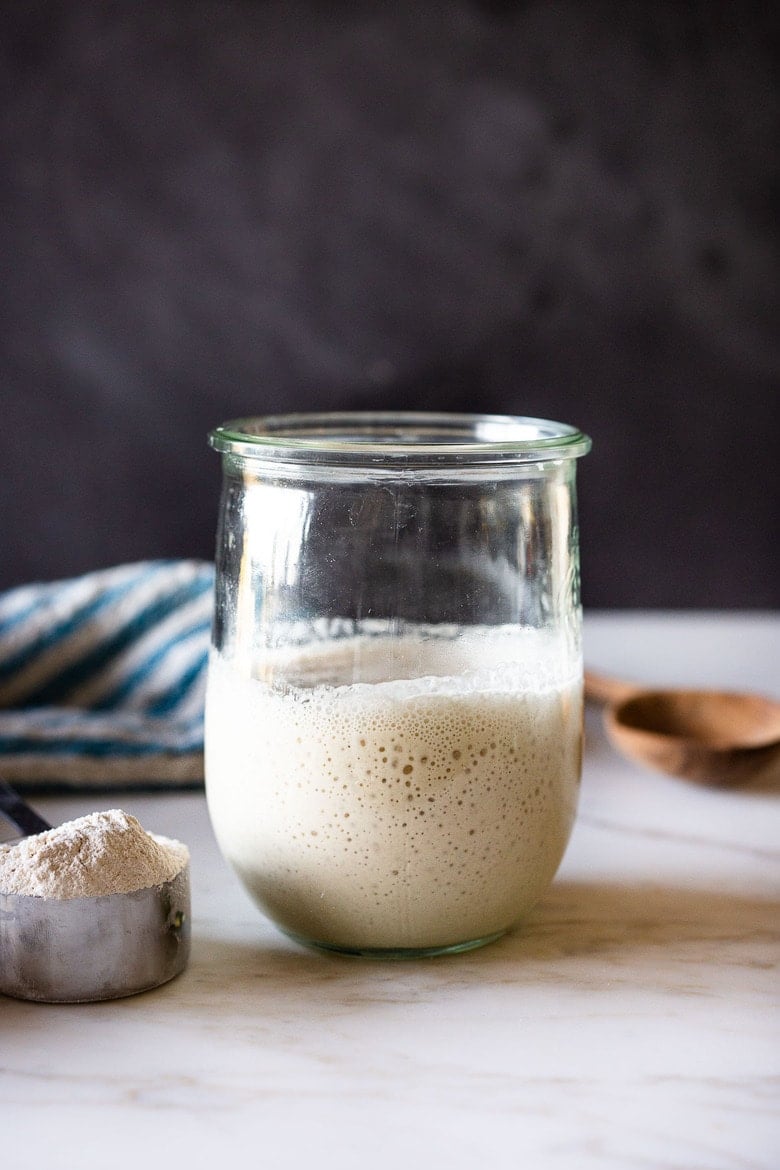
When you understand one thing through and through, you understand everything.~ Shunryu Suzuki
With over 500 five-star reviews and hundreds of success stories, my chef’s perfected sourdough starter guide has everything you need to make your own homemade starter. In just six days, you’ll be baking the most beautiful sourdough loaves!
But first, What is a starter?
Sourdough starter is a “wild yeast” made from flour, water, and the natural wild yeast in the air. With a little care and patience, it ferments, and when strong and active, just a little bit of starter replaces commercial yeast and makes your bread rise, while transforming the gluten in the bread into something more easily digestible. Store-bought yeast is not needed!
How to Make Sourdough Starter | 20-Min Video
***Don’t see the video? Allow 15-20 seconds to load it right here!*** (Still don’t see it? Check that your ad blocker is turned off; use Chrome for the best experience.)
Fast forward to Specific Day by video time (using scroll bar underneath video)
- Day 1 Morning: :23
- Day 2 Morning: 4:10
- Day 3 Morning: 7:00
- Day 3 Evening: 9:12
- Day 4 Morning: 11:50
- Day 4 Evening: 13:37
- Day 5 Morning: 14:45
- Day 6 Evening: 16:50
- Day 6 Morning: 18:12
- Day 6 Evening: 20:10
Sourdough Starter Recipe Ingredients
- Jar – A wide-mouth quart jar or a Weck’s 1-liter tulip jar.
- Flour – 5 lb bag of organic bread flour (plus 1 cup organic whole grain flour )
- Water – filtered water, tap water, or mineral water (specifically, San Pellegrino, for the correct mineral ratio). Distilled water does not have enough minerals.
- Scale – using a kitchen scale is optional but handy.
- Thermometer – Knowing the temp of the starter using a thermometer is optional but handy!
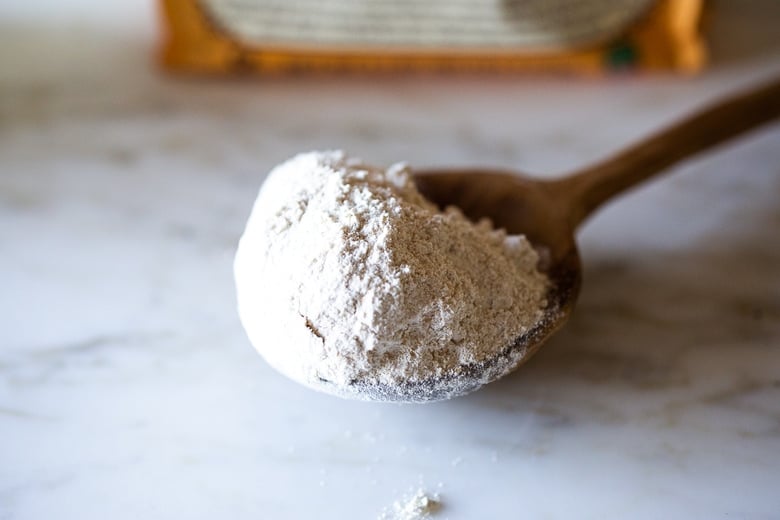
Understanding starter
- Think of sourdough starter as yeast. Only in this case, instead of buying a packet of yeast from the store, you are making your own living “wild yeast” by fermenting flour and water. Once it’s bubbly and happy, it is very much ike a very low-maintenance pet.
- You must feed it (stir in a mixture of flour and water) once a week to keep it active and strong. You know it’s happy when it bubbles. 😉 And YES, you can even name it.
- Some people believe that bread made with sourdough starter is actually better for you than bread made with yeast. Here and Here are a few articles to get you started on your own research. While I’m not sure if this is scientifically proven, I do know that bread made with sourdough starter, tastes infinitely better, feels easier to digest, and has more complexity and better texture, than bread made with commercial yeast. So if you are a bread lover- this is absolutely the way to go, as far as the quality of your finished bread.
How to Make Sourdough Starter
*See the recipe card for detailed instructions.
This recipe for Sourdough Starter takes 6 days (or up to 12 days if it is very cold where you live). For a primer, watch the 20-minute Sourdough Video above!
Day 1: Staring in the morning or at night, using a wide-mouth quart jar, tulip jar, or Crock or Glass Measuring Cup , mix 1 cup whole grain flour (120 grams) with 1/2 cup filtered water (120 grams) using a fork (or chopstick) making sure you’ve incorporated all the dry flour.
Place the lid lightly on top (using the Weck jar lid is really handy here) or a wet towel to keep moisture in, or plastic wrap- and let sit at room temperature (70-ish degrees) on the kitchen counter for 24-48 hours. If you are unsure how warm it is, use a kitchen thermometer and check it a few hours later. See notes for TEMPERATURE.
TIP #1: For your first measurement, weigh the flour using a kitchen scale so you can get an idea of how the mixture should feel. Do not weigh the measuring cup! It should be like a thick paste, like peanut butter. If you need to add a little more water to incorporate the flour, that is OK too!
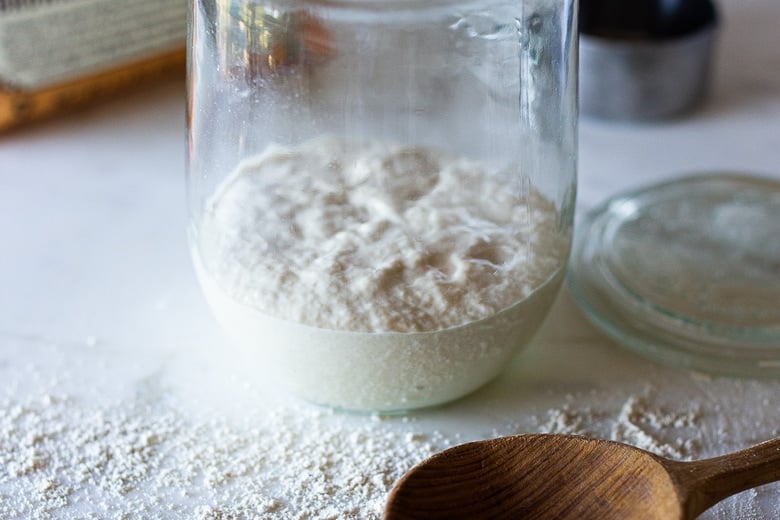
Day 2: After the first 24 hours, there may or may not be a bit of bubbling. Let the mixture rest until you see activity (bubbles or rising) sometimes this takes 36 hours or even 48 hours if very cold. When you see active bubbling, discard all but 1/2 cup of the starter (4 ounces).
To the remaining ½ cup of starter, stir in 1/2 cup water (120 grams), and mix well with a fork. Add 1 cup of organic bread flour (120 grams)spooned and leveled. Stir until combined. Again, it should feel like a thick paste. If overly dry, feel free to add a bit more water. Cover again and allow the mixture to sit at room temperature for another 24 hours.
Day 3: After 24 hours, hopefully, you will see some bubbling or rising and if not, let it go a bit longer until you see activity. Be patient.
Depending on how warm your house is and how active your starter, you may need to begin feeding more often or move to two feedings a day, in the morning and at night. If it is cold, one feeding a day may be enough.
TIP #2: Only feed the starter after it has peaked or looks hungry. See the “3 Signs of Hunger” below. Feeding it when it is “not hungry” will basically dilute all the growing yeast and make it lethargic. Better to underfeed than overfeed.
The 3 Signs of hunger
The photo below was taken after the starter was fed, and after it peaked (reached its highest), and now is sliding down. It is now “hungry” again. See the downward slide marks on the jar? Pay attention – your starter is telling you it is hungry.
- Look for “slide marks” (be sure to use a clean jar so you can see these clearly).
- Liquid at the top of the starter.
- Thin and runny. The starter is liquidy enough to pour out of the jar (when at room temp).

This might be 12 hours, it might be 14, it might be 18, or 24, depending on the temp in your house. In very warm climates, it may only be 6-8 hours. In winter, this may take 36 hours. It is better to underfeed rather than overfeed here.
For each feeding, discard all but 1/2 cup of the starter (keeping roughly ½-cup of starter in the jar). Add 1/2 cup water and 1 cup Bread Flour (spooned and leveled). Mix well, cover, and let this rest at room temperature for 12-24 hours or until the starter looks “hungry” again before repeating.
Day 4: Feed 1-2 times, discarding all but 1/2 cup of starter each time. Feed 1 cup bread flour, 1/2 cup water.
TIP #3: It is typical on day 4 for the starter to slow down and stall a bit. This is OK. Just keep going, be patient and look for the hunger signs, and only feed when clearly hungry. Hopefully, you’ll begin to see some rising and falling. It’s helpful to put the starter in a clean jar each day and mark the beginning level (with a sharpie, string or rubber band) so you can easily see this.
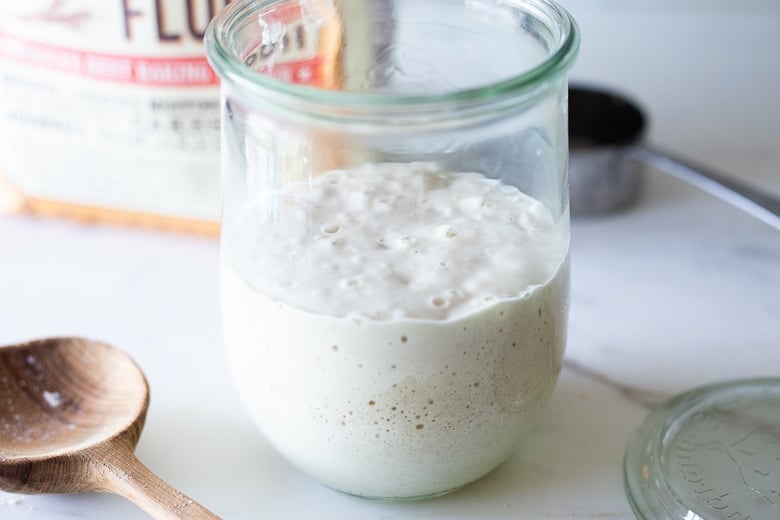
Above, you’ll see it peaking, and below, you’ll see it deflating and getting “hungry.” There may not be too much difference in the beginning, so look closely.
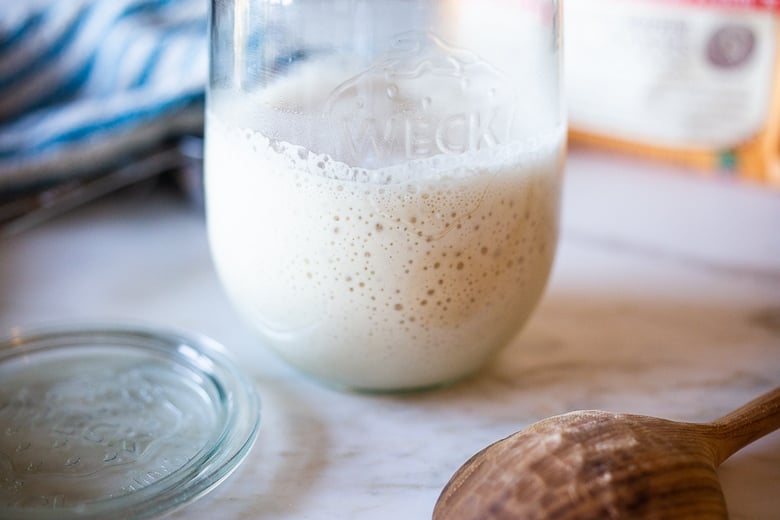
Understand that your starter has a schedule of its own; it is a living thing, so watch it and pay attention.
If your starter is not rising and falling, look at its consistency. As it metabolizes the flour and gets hungry, it will get runny and liquidy, like to the point where you can pour it right out of the jar. If it is still thick like paste, it’s not done metabolizing (eating)the flour.
Day 5: Feed again, 1-2 times, discarding all but a 1/2 cup the starter each time. Adding 1 cup bread flour and 1/2 cup lukewarm water. The starter should look visibly active, bubbling, rising, hopefully, close to doubling in size.
Repeat day 5 until the starter is rising and falling predictably and is close to doubling in size within 6-8 hours.
TIP #4: If your starter is not rising but there is evidence of hunger (liquidy or liquid at the top) try 3 things: substitute 1/4 cup whole grain flour (add to ¾ cup white bread flour) on your next feeding. Try using mineral water like San Pellegrino instead of water. Stir the starter a few times after feeding to allow more wild yeast from the kithcen to get inside.
DAY 6 Morning: Baking day! Give it one last feeding in the morning: this time discard all but a 1/3 cup. (The reason we are changing this to 1/3 cup is to feed it a little bit more.) Add 1 cup flour (120 grams) and 1/2 cup water, stir, and place it in a clean jar so you can see the action clearly. You can use a sharpie or place a rubber band around the jar to mark the beginning level. The starter should hopefully double in volume within 6-8 hours of feeding.
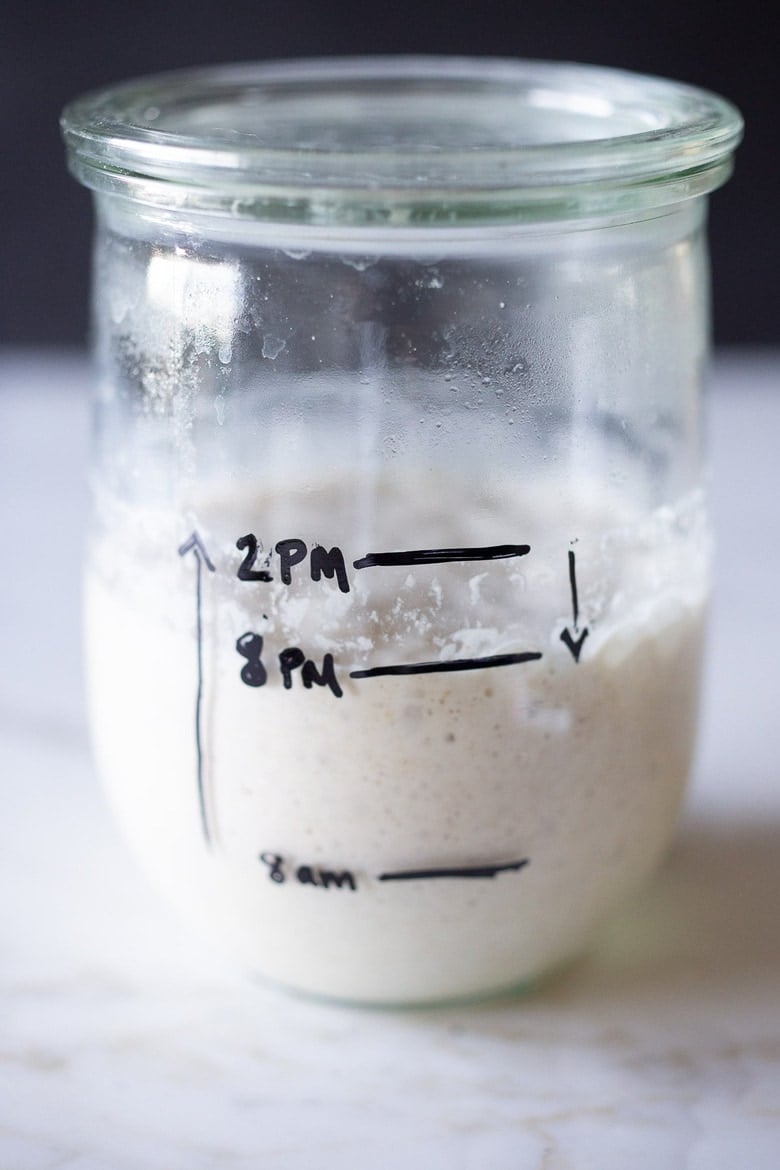
In the photo above, on the 6th day, the starter was fed at 8 am, it peaked around 2 pm, then it started deflating, and by 8 pm, it was “hungry” again. See those downward “slide” marks on the jar?
DO THE FLOAT TEST: When the starter is at its peak, or just after, place a teaspoon of starter (just from the top, don’t stir it down) in a glass full of water; it should hopefully float. If it floats, success!!! Congrats. You can now make our sourdough bread…tonight!
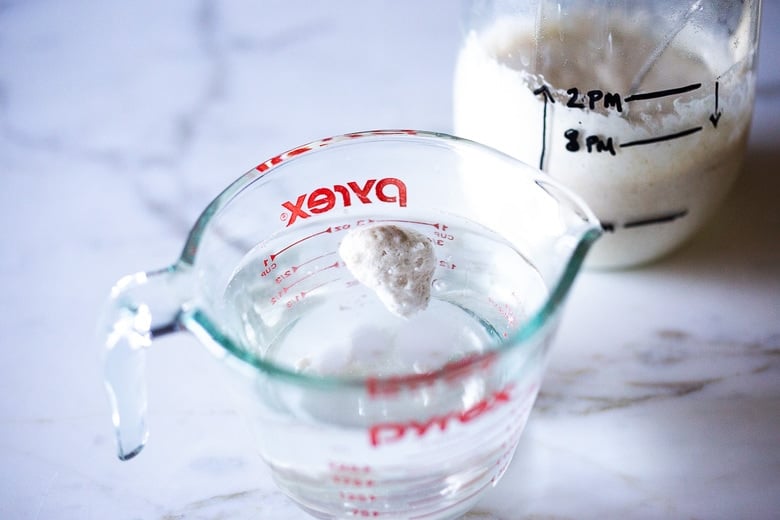
TIP #5: When baking bread always use hungry starter that has already peaked!
STARTER DOES NOT FLOAT? If it doubles in size but does not float, you can still try baking a loaf if it doubles within 6-8 hours of feeding it.
At this point, if your starter does not double in size within 6-8 hours of feeding, don’t give up! Often, it just takes longer, especially during the winter months. Continue feeding one to two times a day until you see a consistent, predictable rise and fall.
Read the troubleshooting section. If you need to take a break, put it in the fridge and try it again up to a week later. Don’t toss it!
Day 6 Evening: Let’s Bake! Use 1/3 cup starter to make this sourdough bread recipe and place the remaining starter (or if not making bread, place all of it) in the refrigerator, and feed it at least once a week, reserving ½ cup starter, before feeding it the usual 1 cup bread flour, 1/2 cup water.
TROUBLESHOOTING Starter
- SMELL: Starter should smell sweet, tangy, earthy, like a wet horse – not “bad”. If it really smells foul or unpleasant, you may have used an unclean jar, unclean utensil, or somehow introduced other bad bacteria. I would start over.
- NO ACTION: On day 4-5 it is typically for it to slow down. If your starter is not rising at all but there is evidence of hunger (liquid at the top, or bubbles) try 3 things. First substitute 1/4 cup whole grain flour (add to ¾ cup white bread flour) on your next feeding. If no rise, then try using mineral water, specifically San Pellegrino instead of water. San Pelligrino specifically has the right mineral ratio, I have great luck with it. Others not so much! Also try stirring the starter a couple of hours after feeding, a couple of times throughout the day to allow wild yeast from the room to get in there. Lastly, you could try pineapple juice instead of water.
- FLOUR: Try to use fresh milled whole grain flour to start, then organic BREAD FLOUR. The more wild yeast in the flour, the better your starter will do- so smaller brands like Bob’s Red Mill seem to do better than bigger conventional brands that have been overly processed. It is totally OK to mix flours and to switch them up- this adds different kinds of wild yeast- a good thing!
- DO NOT overfeed. For example, maybe feeding 2 x day at 12-hour intervals is too often. You want to feed after the starter has peaked, then deflated (see photo above- you’ll see some slide marks on the jar) and this tells you that it is hungry. If you feed the starter before it has had a chance to metabolize (or eat) all the flour (before peaking) and then you discard part of it, and feed it again, you are actually diluting all that amazing bacteria, weakening your starter. So it’s all about watching your starter in your home. If you are not seeing rising and falling, but notice the starter just gets liquidy, this too is a sign of “hunger”. Or if it gets runny enough to pour out of the jar, another sign it is hungry. There are lots of variables here. Just be patient, pay attention and watch. This is a living thing- it doesn’t care about time schedules and recipes or what it “should” do. It will “eat” when it is “hungry” and sometimes it likes to eat slowly. 😉
- TIME: It may take longer than 6 days in colder environments. Use a kitchen thermometer and take its temp. Is it over 65F? Find a place where it can be warm. In the oven with the light on, or in an upper cupboard ( heat rises). Sometimes it takes 12-14 days! Be patient, keep going. If it is doing absolutely nothing, leave it out on the counter for 24-48 hours and see what happens. If you run out of flour or need a break, don’t just toss it, put it in the fridge and see if you can get it going a few days later.
- ACIDITY: If you still can’t get that starter going, some people recommend subbing pineapple juice for the water for one feeding- raising the acidity level. My good friend just tried this and it got hers going.
- LIQUID: If you see any liquid at the top of your starter, it means your starter is hungry. So, yes it’s still alive which is a good thing! You can stir the liquid in, or pour the liquid out, either way, but feed it. This is a sign that you may need to feed it more often.
- MOLD: if you see any discoloring or mold on the surface, starter was probably contaminated. If it is only on the surface, it is probably ok to save. Scrape it off, save 1/2 cup of the underneath starter, and keep going, using a clean jar. Feed, smell, use your best judgment.
- FLOAT TEST: Try testing when your starter is peaking. Take a spoonful from the top without stirring it down. If your starter is rising and falling consistently, but not passing the float test and it has been over 8-10 days- just try baking a loaf. People are having luck with good loaves without passing the float test. It may be the flour…
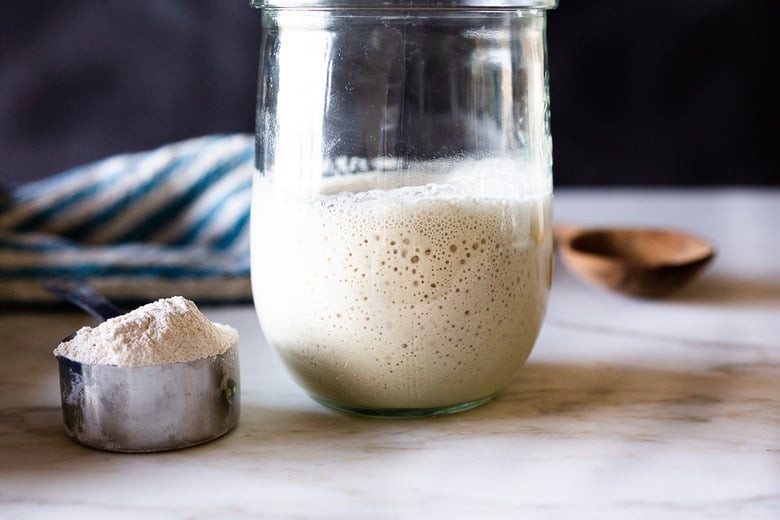
How to Maintain Your Starter
- REFRIGERATE & FEED AT LEAST ONCE A WEEK: Pick a scheduled day and try to stick with it, always reserving 1/2 cup and feeding it 1 cup flour and 1/2 cup water. Discard the remaining, give it away, or keep the discard in a separate container for sourdough pancakes, sourdough buns, banana bread, biscuits, etc. I usually don’t feed the discard unless I give it away.
- If you forget to feed it one week, it is most likely OK; feed it 1-2 times a day for 1-3 days in a row to revive it (keeping it out on the counter) until bubbly and active and doubles within 6 hours. I’ve left my starter for a month on vacation (in the fridge) without feeding and simply revived it by feeding it 3 days in a row, 1-2 x day. It’s surprisingly hard to kill. You can also freeze it for more extended storage.
- This batch will allow you to bake 2 loaves of bread per week with enough left to feed for the next week. If you want to bake more often, you can keep it out and feed it 1-2 x daily. Or if baking every few days, you can pull it out of the fridge, feed it 10 hours before using, leaving it out, use what you need while it is peaking (or slightly after), then put it back in the fridge that evening. Do the same thing a few days later when ready to use again. So this would be feeding 2-3 times a week, best if baking 4-5 times a week.
The best time to use sourdough starter is just after it peaks or on its way down when you know it is hungry.
Sourdough Bread Starter FAQs
Yes. While you are building your starter, during the first week, it is the simplest, easiest, fastest, and most economical way to create a healthy starter. (Or save it separately -in the fridge- and use it in Pancakes, Waffles, Buns, or Biscuits. ) This is because you always have to feed it two times its volume in flour. For example-if you kept all the 1 1/2 cups of starter, you would have to feed it 3 cups of flour (instead of keeping just a 1/2 cup and only feeding it ONE cup). Discarding will shorten the fermentation process, require less flour in the long run, and create a stronger starter. Once your starter is “established” after the first week- then you can give it away to friends, use it in pizza dough, pancakes, etc) or give it to a friend.
How to use your Sourdough Starter
- See all our Sourdough Recipes!
- Sourdough Scones
- Sourdough Crackers
- Sourdough Biscuits
- Sourdough Buns
- Sourdough Tortillas!
- Vegan Banana Bread
- Overnight Sourdough Waffles
More from Feasting At Home
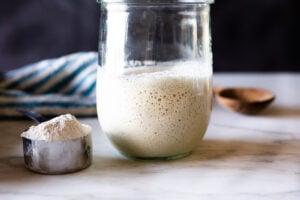
Simple Sourdough Starter
- Prep Time: 30
- Cook Time: 6 days
- Total Time: 144 hours 30 minutes
- Yield: 1 ½ cups
- Category: sourdough, fermented, cultured, bread, baking,
- Method: fermented
- Cuisine: bread
- Diet: Vegan
Description
How to make your own Sourdough Starter (see the step-by-step video in post) using simple ingredients with no special equipment, in 6 days, that can be used in sourdough bread. Sourdough Starter is a wild yeast, made from fermenting flour and water.
Ingredients
- 120 grams whole grain flour (whole wheat flour, rye flour, or freshly milled flour) 1 cup, fluffed, spooned and leveled
- Organic White Bread Flour (5-10 lb bag ) I like Shepherd’s Grain or Bob’s Red Mill.
- 120 grams Water per feeding (1/2 cup water)
Instructions
-
- Day 1: Starting in the morning or at night, using a wide-mouth quart jar or Crock or Glass Measuring Cup mix 1 cup whole grain flour (120 grams) with 1/2 cup (120 grams) filtered water using a fork making sure you’ve incorporated all the dry flour. For your first measuring – it is a good idea to weigh the flour, using a kitchen scale so you get an idea of how thick it should feel. It should be like a thick paste. Thick like peanut butter. If you need to add a little more water to incorporate the flour, that is OK, but be precise with the flour. Place the lid on top (using the Weck jar is really handy here) or a damp towel to keep moisture in, or plastic wrap- and let sit at room temperature (70-80 degrees) on the kitchen counter for 24-48 hours, or until you see some bubbling. If you are not sure how warm it is, use a kitchen thermometer and check it a few hours later. See notes for TEMPERATURE.
- Day 2: After the first 24 hours, you may or may not see a bit of bubbling. I prefer to let this rest until I see a tiny bit of activity (bubbles) and sometimes this takes 36 or up to 48 hours. So start “day 2”, when you see a little bit of bubbing. Discard all but 1/2 cup (136 grams) of the starter. (See notes for discard). Add to the remainder, 1 cup of white bread flour, (120 grams), spooned and leveled, and 1/2 cup filtered water (120 grams), mixing well with a fork. Place the lid on loosely again and allow the mixture to sit at room temperature (70-80F) for another 24 hours.
- Day 3: By the third day, you should definitely see some bubbling- and if not, let it go a bit longer. Depending on how warm your house is and how active your starter, you may need to begin feeding more often, or even move to two feedings a day roughly 12 hours apart, like in the morning and at night. In a nutshell, you want to feed the starter only after it has peaked (metabolized all the flour from the last feeding) and has started sinking down or gets liquidy- this is when it is hungry! This might be 12 hours, it might be 14, it might be 18, or 24, depending on the temp in your house. In very warm climates it may only be 8 hours. It is better to underfeed rather than overfeed here. For each feeding, like before, discard all but 1/2 cup of the STARTER (keeping roughly ½-cup of starter in the jar -4 ounces or 136 grams) Add 1 cup Bread Flour (spooned and leveled) and 1/2 cup water to the 1/2 cup starter and let this rest at room temperature for 12-24 hours or until the starter looks “hungry” again before repeating.
- Day 4: Feed 1-2 times, discarding all but 1/2 cup of starter EACH TIME. Feed 1 cup bread flour, 1/2 cup water. Look for the hunger signs. Hopefully, you’ll begin to see some rising and falling. It’s helpful to put the starter in a clean jar and mark the beginning level (with sharpie, string or rubber band) so you can easily see this. ***If for some reason your starter looks like it is still rising at the time of second feeding (at night) and there is no evidence it has fallen or no slide marks, it is still “eating” so skip this feeding and feed first thing in the morning. AGAIN, Feeding it when it is “not hungry” will basically dilute all the growing yeast and make it lethargic. Better to starve than overfeed.
- Day 5: Feed again, 1-2 times, roughly 12 hours apart, or when hungry, discarding all but a 1/2 cup the starter EACH TIME. 1 cup bread flour, 1/2 cup lukewarm water. The starter should look active, bubbling, rising, sliding down, hopefully, close to doubling in size. (If not, repeat this day until starter doubles in size within 8-12 hours of feeding- and read the troubleshooting section.)
- DAY 6: Give it one last feeding. Discard all but a 1/3 cup. Add 1 cup flour ( 120 grams) and 1/2 cup water, and place it in a clean jar so you can see the action clearly. You can use a sharpie or place a rubber band around the jar to mark the beginning level. The starter should hopefully double in volume within 6 hours of feeding. When it peaks, DO THE FLOAT TEST: To test the starter, place a teaspoon of starter (just from the top, while it is peaking, don’t stir it down) in a glass full of water, it should hopefully float. If it does, you can make sourdough bread. Tonight! Let the starter keep resting at room temperature or a few more hours allowing it to fully metabolize the flour, perhaps sinking a little before making your dough. You want to make dough with slightly hungry starter. Place the remaining starter in the fridge and feed it in a week. You’ll have enough stater to make one more sourdough loaf during the week, and still have enough to feed. If you want to wait to make bread until later in the week place starter in the fridge. Be sure to feed it in 7 days. Read maintenance section.
- At this point, if your starter does not double in size don’t give up! Often it just takes longer, sometimes up to two weeks, especially if it’s cold. Continue feeding one-two times a day (only when hungry) for a few more days, until you see a visible rise and fall. Read the troubleshooting section. If you need to take a break, just put it in the fridge and try it again up to a week later. Don’t toss it- if there are bubbles, it is still alive.
- This batch of starter will make two loaves of bread with enough left over to feed for the following week.
Notes
- TEMPERATURE: The colder your home, the longer it will take for the starter to grow and become active (bubbles). Find a warm spot (70-80 degrees) for the best results. On the stovetop, with the light turned on, or on top of the fridge. Or in the oven with the light on. On top of a heating pad (set to low) with a towel in between). You can still make the starter in a colder home, it will just take longer- even up to 2 weeks.
- FLOUR: Always try to start the batch by using organic, freshly milled whole-grain flour (wheat or rye) because it has more wild yeast in it than All-Purpose or white flour and will get it active and growing sooner. You can, of course, continue to use whole grain, but I’ve had the best luck using organic “bread” flour for days 2 through 6. People have made a sourdough starter with All-Purpose flour- but personally, this has never worked for me– there are fewer nutrients and wild yeasts in the flour and results in a very lethargic starter. If it is your only option, try mixing in 2+ tablespoons of whole-grain (wheat or rye) with the AP flour per feeding. Feel free to use different flours or mix different flours together. It is OK to use all-purpose flour if in a pinch, but using it repeatedly will result in sad starter.
- WATER: I usually use tap water -but sometimes the chlorine in tap water can inhibit the growth of your starter. Lukewarm water helps fermentation to start faster. Sterilized bottled water is often overly sterile, and can also inhibit. Mineral water, like Perrier (carbonated is OK) can sometimes work miracles.
- HYDRATION: Hydration refers to the ratio of water to flour in terms of weight. It is a ratio. The starter is typically at 100% hydration- meaning equal parts flour and water, in terms of weight. So if you use 120 grams of water, use 120 grams of flour. This roughly translates to 1 cup of flour and 1/2 cup water. Feel free to weigh instead of measure if you want to be more precise, or want to familiarize yourself with the consistency you are aiming for. If using whole grain flours (which tend to be “thirstier”) and your starter seems very thick, it is totally OK to add more water to thin it a bit. I intentionally keep the hydration a little lower here (a thicker starter) so you can more clearly see the rise and fall “action” in the jar.
- STORING AND FEEDING: When your starter is kept cold, in the fridge, you don’t need to feed it as often- only once a week. Feel free to feed it “cold”, and put it right back in the fridge if you like. If you keep it out on the counter, you’ll likely need to feed it 1-2 x daily (or just watch and feed only when hungry). Cold slows down the fermentation, heat speeds it up.
- USING: When you need to use your starter for baking bread, feed it 10-12 hours before making bread dough, using it after its peak height. For a more “sour” flavored bread, use the starter straight from the fridge, 3-6 days after feeding. The starter gets more sour tasting the longer it goes without feeding. Feeding the starter the same day as making bread will produce a milder sourdough flavor.
Nutrition
- Serving Size: 1 tablespoon
- Calories: 31
- Sugar: 0 g
- Sodium: 0.2 mg
- Fat: 0.1 g
- Saturated Fat: 0 g
- Trans Fat:
- Carbohydrates: 6.2 g
- Fiber: 0.2 g
- Protein: 1 g
- Cholesterol: 0 mg
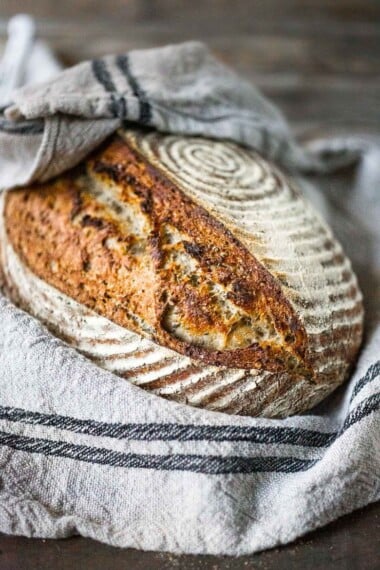

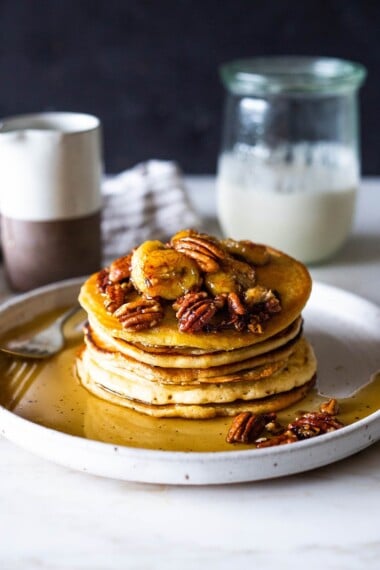
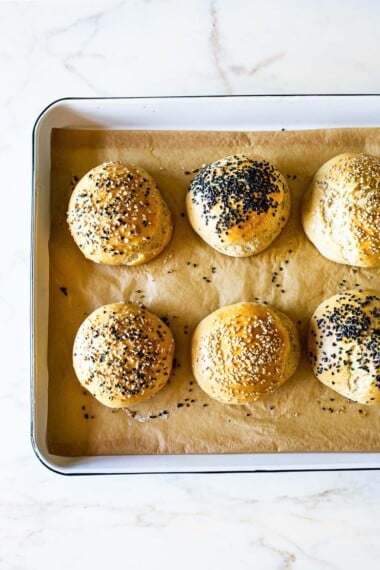







Hi there!
This is really helpful thanks so much. I wasn’t able to find bread flour, so had to start with rye and then was feeding with AP flour. It worked, but was a bit sluggish so started feeding with rye a couple times and it got it going. Someone recently told me that if I continued feeding with rye flour only, I wouldn’t be able to use it in most recipes, so I switched back to AP, but it slowed down. Is it true that rye only starter will limit my baking options? And if so, do you recommend feeding with half and half rye and AP?
Thank you!
I think you can use rye in many recipes! You could also do a mix. 1/3 rye, 2/3 AP flour.
I had great success with this! I started with King Arthur white whole wheat flour and followed up with Ardent Mills organic bread flour – it was very active right away! The only difference for me was that my organic bread flour seemed to be slightly heaver than 120g for 1 cup, as it got too watery/didn’t rise as well when I weighed (bowl zeroed out) vs. used measuring cups. Thank you for all of the tips, advice, and videos! I followed the instructions for the no-knead sourdough bread recipe for my first bake, and I had to stop myself from eating the entire loaf in one sitting.
Thanks for this and great to hear Alison!
Hi! Thanks for all the info on making a starter. I’m on day 12 and it just passed the float test this morning. I haven’t fed it in over a day. I last fed it in the morning on Day 11 and this morning it had tripled in size and was full of bubbles and looked great. I didn’t feed it and now (evening Day 12) it has shrunk back down almost to the same size as when I last fed it.
Since I can bake with it, how should I feed it? Should I take out the amount to bake with and then feed it and put it in the fridge or do I feed it, wait a day, and then take some of it to bake? Thank you!
You could do it either way!
Hello dear
I am in day 4, yesterday it came out of the jar and i am supposed to feed it twice, however, it didnt rise again. Should i wait until its really hungry or do i have to feed it twice a day?
Hi – wait until hungry. 🙂
Thank you for the best sourdough starter recipe ever! I have shared this recipe with all my friends. This was my first time ever making starter on my own and I’m no baker, but my first load turned out amazing! This Friday will be the first week that the starter has been in the fridge. I plan to feed it Friday. I would like more starter though so that I can bake maybe twice a week. I have a couple questions. Would I keep 1 cup of the starter and use 1 cup of water and feed it 2 cups of flour? if I do this, will that effect the sour taste to my starter? Or Would it be better to start another jar from day 1 to make more starter?
Hey Sandrea- I would just save double and feed double. Or even just 1.5 times may be enough instead of double. You can also feed the starter more often by leaving it out of the fridge. For example, people who bake like every day, leave the starter out ( don’t refrigerate) and feed when it is hungry which will be 1-2 times a day. You will end up with a lot of discard, but if baking a lot, you’ll use this.
Hi
I ‘ve started my sourdough journey yesterday. (I’m on day 2) and today i fell across your blog and i m sad i didnt see this when i started. I have started with 50gms of A.P flour and 50gms water. I live in India where its 90-95 F . and my starter seems to be asking for more feedings ( slight smelly liquid on top). There was a lot of co2 bubbles today morning. Am i doing anything wrong? Can i add wholewheat flour for feedings instead of A.P flour since its not very easily available during the lockdown?
Yes, add whole wheat, watch the video and feed when hungry- liquidy.
just started this last night. I have NEVER baked bread in my life and now have a bread machine. I hope i get this right! Thanks for posting this recipe. Ill keep you posted!
Let me know how it turns out. Have not tried this in a bread Machine.
Hi Sylvia,
When you keep the starter in the fridge… do you feed and then put in fridge, or remove what you need to bake after feeding in morning and then put remainder in fridge?
Thanks Allison
Hi, yes, you can feed it and put it right back in, and use the discard for baking (using it unfed as long as it’s within the week of the last feeding).
Sorry Sylvia, I forgot to rate the recipe and wanted to thank you for the other two recipes I tried with the discard while making the sourdough starter. The quick sourdough buns and the banana bread were both delicious and easy to follow along with your instructions.
Greatly appreciate your expertise, thank you~
Christina
Awww thanks so much!!!
Hello, I have finally achieved a floating starter and am in the process of trying the overnight dough recipe. Thank you for all the great info and the easy to follow video! I am a visual learner so it was the most helpful to me. Just wanted to be sure, I used a 1/3 c. of starter for the recipe, did not feed it and put all of the remainder in a clean jar into refrigerator without feeding this remainder again today? Feels strange to not feed it as it has become habit. Understanding that I feed it when I am going to use it again or 1 x a week.
Thank you for your reply, I’d hate to mess it up now.
~Also, the suggestion of the pineapple juice completely saved my starter when it was tired and sad. So happy I listened to you and did not give up. Thank you so much for sharing,
Christina
Great to hear! So glad it worked for you! Yes, you did it right. You can use it again during the week without feeding, but feed if using on day 7.
Hi ok my mixture keeps rising! It’s day 4 and last night it came out the container. Today fed it around 9 and nearly coming out top again what do I do?????
Are you removing all but 1/2 cup when you feed it?
Yes I am every time.
Your video isn’t available! I watched it last night but this morning it’s gone! Is it my computer or did you take it off? It’s not on you tube either. I’m on day 4, morning, and the starter has risen but not deflated. Do I still feed it? Thanks!
Hi Carla- video is there, try refreshing your page? Or try a different Browser? Give starter a little more time, let it sink just a little before feeding. 🙂
Hi
I’m on day 5 of my first starter. Yesterday I fed it in the morning and it more than tripled and started to slide by 12 hour mark. I fed it again last night, and I could see this morning that it had doubled and slid all the way back down. I fed it again this morning and now 3 hours later it has tripled and just started to slide down. I tried the float test and it floated. Is it ready to use even though it’s just day 5? I’m in Florida and my house’s A/C is set at 75. Should I now start maintenance?
It sounds ready to me, but I’d go one more day just to be sure! Either way would probably be fine!
Hi! Does it matter the thickness of the starter?
Hi, Just try to get it similar to the video. Always weight the flour, but if you need to add more water than stated, that is ok.
Hi! Does it matter how thick or thin your starter is? Mine has become thicker the more I feed it….🤔 I’ve already baked some beautiful loves. It’s been about 3 weeks of baking a loaf a day and feeding it! 😊 I have been using it straight out of the fridge. Is that why it’s so thick?
Yes, it might be thicker because it is cold?
Hi
While I am still at Day 2 of the starter, I wanted to clarify few things.
After we refrigerate the sourdough starter and have to feed it weekly,
1) Do I discard 1/2 the starter and add the 1cup flour+1/2cup water (as we did during the process ) every time I feed it?
2) When I put in the flour + water during this weekly feed do I keep the ‘now fed’ starter back into the fridge or should I keep it outside? If outside, then for how long?
3) If I have to make bread the next day, should I keep my starter outside the night before or I can take it when I need to mix it for the bread dough?
4) When I put the starter inside fridge, do I screw on the lid or just keep the lid on gently (as during the process of making the starter)
I apologise for having such basic queries but hope that you could clarify
Thanks
Deepti
1. Yes, discard all but half cup, feed 1 c flour and 1/2 cup water.
2. If using that evening after feeding, keep it out until you make dough.
3. If making the next day, I would still leave it out for a few hours after feeding to digest some of the flour, then put it in the fridge that night. If making bread on like day 3-6, jut put it in the fridge.
4. Leave the lid on lightly, not screwed. 🙂
Thank you Sylvia! Finally found a starter that works! Your instructions and video are informative and easy to follow, especially for a novice like me. I’ve made your sourdough bread and pancakes – easy and so delicious! I’ve also used your starter to make awesome pizza dough. THANK YOU AGAIN!
I didn’t get past the first step. I don’t see how you can get a peanut butter consistency with those proportions. I got a thick lump of dough. Nothing like the pictures. After three days at 75°F, it’s still just a lump of thick dough.
Hummm, it sounds like too much flour. I’d just add a bit more water and see what happens. Did you weigh it?
I have learned that there is too much flour when using a measuring cup. I find that weighing the flour I use less flour and don’t have this problem any longer. Good luck!
Good Morning!
I followed your recipe exactly and had fantastic results with my bread. My starter floated and I was thrilled. I made several loaves of bread and had much success. However, I had to be out of town so I put the starter (which passed the float test) in the fridge. This is where I am confused-do I need to feed my starter again (the refrigerated starter sank like a rock)…and if I do need to feed it how often? There was hooch in it.
Second question-can I ever use starter directly from the fridge without having to feed it/how long is it good (still pass the float test)?
Thank you so much. I am having so much fun making this bread.
If you see any liquid (Hooch) feed it.Feed starter once a week when kept in the fridge. It can usually last 2-3 weeks, and still recover, but 1 week is ideal. You can use the starter directly from the fridge without having to feed it ( within that week of feeding). If you want the bake the same day that you feed it, leave it out of the fridge so it has achance the process the flour and get bubbly first.
I have been using the sourdough discard for biscuits and just tried discard sourdough crackers and it turned out amazing. I can’t wait to try making bread.
I am on day 6 and I was wondering if I should be stirring the sourdough starter in the jar before taking out 1/3 cup? I was also wondering if I should have stirred it on the other days as well before taking out 1/2 a cup or does it not matter if it is stirred or not? Does the starter also need to be stirred before I start the feed while it is in the fridge too once I have completed everything and start the weekly feedings?
No need to stir the starter. 🙂
Hi Slyvia. I’m totally new with sourdough. Once the day 6 is complete. When can we start baking our1st bake? Do We take out the amount needed for baking or the amount needed to be fed and kept in the fridge? Sorry if I sound silly. Thank you so much
You can start the eveing of day six with my sourdough bread recipe (it rises overnight and you bake it in the morning) or just put it in the fridge and make bread with it within the week.
Hey Sylvia!
I’m on my second batch (first batch started to get moldy so I decided to start over). It is day 3 and the starter has doubled in size since yesterday, but I have not noticed any slide. There doesn’t appear to be much liquid on the surface, but it does look a bit shiny and wet around the edges. Should I wait to feed it until it visibly slides? Or feed it anyway?
Thanks!
I would wait. 🙂
I’m making your sourdough starter recipe and am on day 3 morning. All seems to be going well. My concern is that when I weigh my 120 grams of bread flour it only fill my 1 cup measure a little over half full and you say it should be a slightly heaping cup. I’m using King Arthur unbleached bread flour. So should I go with the slightly heaping cup of stick to the 120 grams?
120 Grams. Try fluffing, and spooning your flour into the cup. 🙂
I’m on the morning of day six, see some bubbles but hasn’t risen at all. I mixed a little whole wheat with the bread flour last two feedings to give it a boost. Should I go ahead a feed it again or wait till it rises? Or start over? Temperature is between 70-80 degrees.
Don’t start over. Let it really really hungry, maybe let it go 24 hours, and try feeding again and see if it rises?
Hi Sylvia,
Thanks for sharing your recipe. I’m at Day 3 – this morning at 7:50am the starter starts to have liquid forming at the bottom. I gave a quick stir and discard half and fed it. Couple of hours later (about 4 -5 hours), it double in size and an hour later starts to slide down. At the 8th hour mark, I fed it for the 2nd time however 4 hours later, liquid starts to form at the top. I stirred in the liquid and discard half and fed it for the 3rd time. Am I doing the right thing so far?
Are you discarding 1/2 of your starter? or discarding ALL but a half-cup? Discard ALL but a 1/2 cup, then feed that. You may be not giving enough “food” (flour). It sounds likes it is getting hungrier, faster.